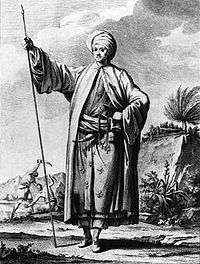Danish Arabia expedition (1761–67)
| Native name | Den Arabiske Rejse |
|---|---|
| Duration | 6 years, 320 days |
| Date | January 4, 1761 – November 20, 1767 |
| Location | Middle East |
| Type | Expedition |
| Patron(s) | Frederik V of Denmark |
| Organized by | University of Copenhagen |
| Deaths | 5 |

The Danish Arabia expedition (Danish: Den Arabiske Rejse) was a Danish scientific expedition to Egypt, Arabia and Syria. Its principal goal was to elucidate the Old Testament with additional research goals concerned with natural history, geography and cartography.[1] It had six members of whom only Carsten Niebuhr survived, returning to Denmark in 1767. The journey has been chronicled by Thorkild Hansen in his novel Arabia Felix.
The expedition
The expedition departed from Copenhagen in 4 January 1761, and, landing at Alexandria, ascended the Nile. Proceeding to Suez, from where Niebuhr made a visit to Mount Sinai, in October 1762 the expedition sailed to Jeddah, and then journeyed overland to Mocha. Here, in May 1763, the expedition's philologist, von Haven, died, and shortly afterwards its naturalist Peter Forsskål also died. The remaining members of the expedition visited Sana, the capital of Yemen, but suffered from the climate and returned to Mocha. Niebuhr seems to have preserved his own life and restored his health by adopting native dress and eating native food. From Mocha the expedition continued to Bombay, the expedition's artist dying en route and the surgeon soon after landing. Niebuhr was now the only surviving member. He stayed in Bombay for fourteen months and then returned home by way of Muscat, Bushire, Shiraz and Persepolis. His copies of the cuneiform inscriptions at Persepolis proved to be a key turning point in the decipherment of cuneiform and the birth of Assyriology. He also visited the ruins of Babylon (making many important sketches), Baghdad, Mosul and Aleppo. He seems also to have visited the Behistun Inscription in around 1764. After a visit to Cyprus he made a tour through Palestine, crossed the Taurus Mountains to Brussa, reached Constantinople in February 1767 and finally arrived in Copenhagen the following November.[2]
Members of Expedition
Six people went on the expedition, with five of them dying. † denotes which members died on the expedition.
- Peter Forsskål†: Swedish natural scientist, and student of Carl von Linné; his main tasks was to find supporting evidence for a number of Linné's accounts.[2]
- Frederik Christian von Haven†: Philologist, was tasked to purchase oriental manuscripts and to transcribe inscriptions. Furthermore, to make observations on the Arabic language, with a focus to help on the obscure passages of the Old Testament.[2]
- Carsten Niebuhr: Cartographer, was to observe and take measurements for mapping.[2]
- Christian Carl Kramer†: Physician, was to research a number of medical questions, both on the scientific and also on a more practical level, among the people of Arabia.[2]
- Georg Wilhelm Baurenfeind†: Artist and painter, tasked to sketch the finds of the others.[2]
- Lars Berggren†: Acted as orderly on the trip.[2]
References
- Anne Haslund Hansen: Niebuhr's Museum. Niebuhr's Museum. Artefacts and Souvenirs from the Royal Danish Expedition to Arabia 1761-1767. Copenhagen 2016
- ↑ Vermeulen, Hans (2008). Early History of Ethnography and Ethnology in the German Enlightenment: Anthropological Discourse in Europe and Asia, 1710-1808. Leiden: Privately published.
- 1 2 3 4 5 6 7 Rasmussen, Stig T. "The Arabian Journey 1761-1767". kb.dk. Royal Danish Library. Retrieved 1 March 2016.
External links
- The Arabian Journey 1761-1767
- Article (in Danish)